Intel has an ultra-exciting line coming codenamed “Meteor Lake” which is set to unveil a set of major packaging changes. With that change, Intel is also overhauling its branding making the names of some CPUs slightly shorter while making names for its high-end chips much longer. This follows the unveiling of its new 3rd Generation Intel Logo in 2020.
Intel Overhauls Core Branding with Meteor Lake
On the subject of generation, Intel is finally removing the generation from its branding. We would have things like the 12th Generation Core, people would still use “Alder Lake” but then the products would have a “12” in the model name. That is gone with the new generation later in 2023.
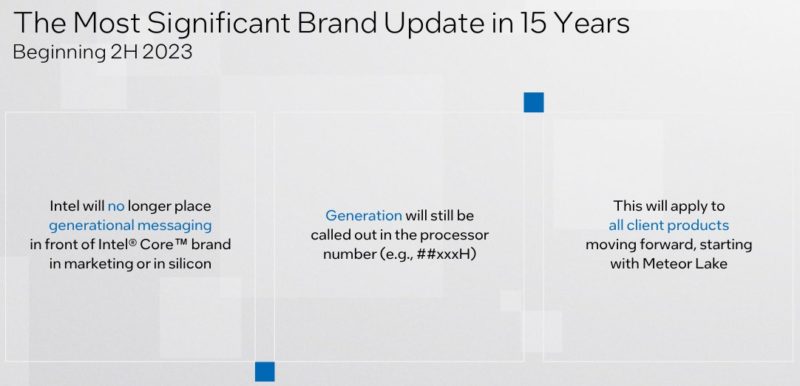
The next shift is that there will no longer be a “Core i7”. Instead, it will be Core 7. Intel is doing this to distance itself from its legacy of making best-in-class processors and instead position its naming closer to the AMD Ryzen series that has used “Ryzen 7” without the “i” for its tiers since its inception.
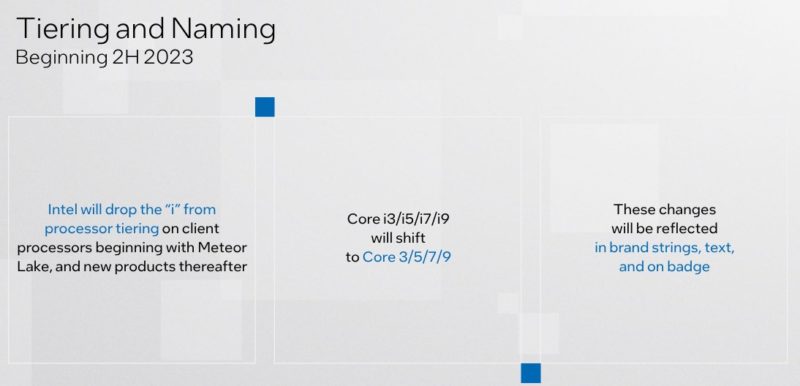
That is not the only change. Having a Core i7 today means that a consumer is buying a better processor than the Core i5. That stratification will no longer be true.
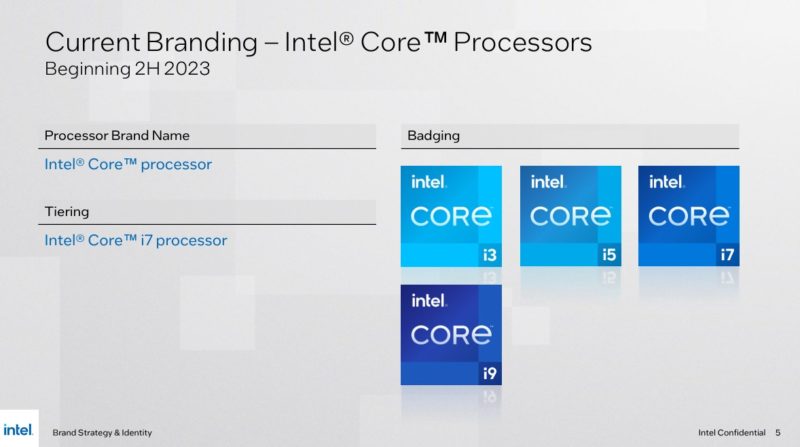
Instead, we will get a split between an “Intel Core” and an “Intel Core Ultra” tier.
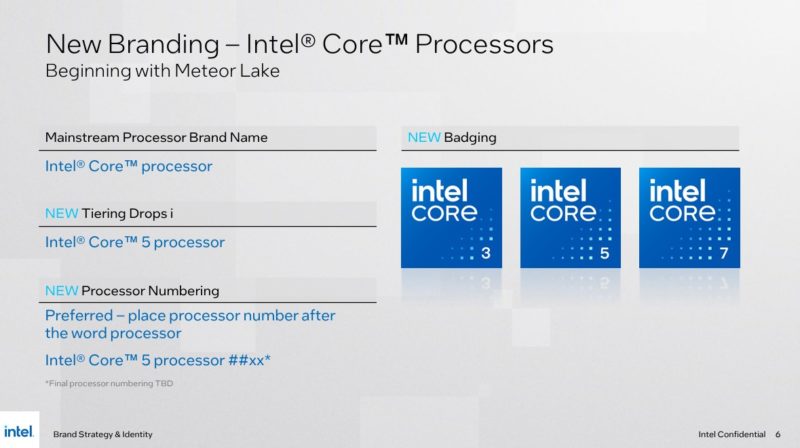
This means we will now have an Intel Core 7 and a Core 7 Ultra instead of just having a Core i7. Is a Core 5 Ultra may be a lower tier than the Core 7 Ultra, but is it a lower tier than the Core 7?
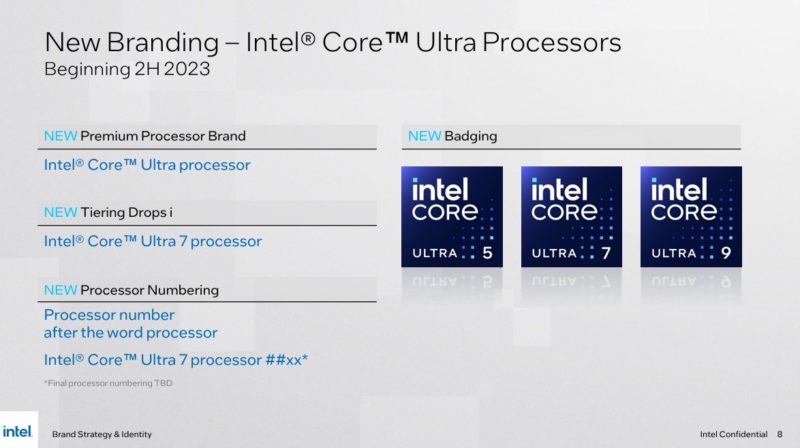
There is also a “processor” in the naming scheme that we are just not going to use as it makes the branding too long to type. Our expectation is that, as with the current branding where it is rarely used, it will continue to be unused by most in the industry because it makes the naming obtrusively long.
Final Words
Our best guess on why Intel is doing this is:
- The Intel branding team needed to show its value add
- Intel wanted to align more closely with AMD branding on the desktop
- Intel is looking to a world of managing multiple product generations in parallel
All three make sense. In large companies, teams need to show their value add on a regular basis. Changing something in an organization that has been constant for 15 years is a great way to show your team’s impact. We are also seeing the impacts in many non-gaming segments where 11th Gen, 12th Gen, and 13th Gen Core parts are being sold in parallel. Removing the generation means that, while we will still use generations to describe processors or platform codenames, the average consumer will just see something like Core 7 1464 and Core 7 Ultra 1554 and not think there is a new architecture. This shift in branding is required if Intel wants to sell 3+ generations concurrently going forward.
We are sure folks are going to have opinions on this one.

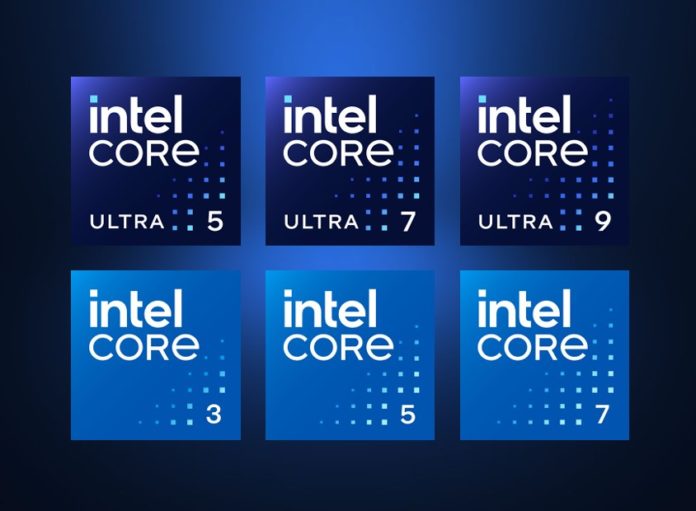
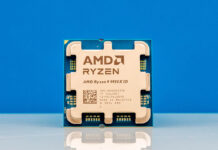


This… isn’t surprising. At least they didn’t call them Core Ark 7.
I think the Core [Ultra] separation does make sense in a world where we are seeing chips with all E cores or other mixes, especially as those look to have enough oomph to get a lot of basic day-to-day needs taken care of.
I still think this is a missed opportunity to bring back the Core “Extreme” name- maybe we can still hold out hope.
Marketing has reasons that reason ignores.
Anyway, what matters the flask if drunkeness be within?
Ryzen is a made up word that leads to unique matches for web searches and a strong trademark; Core i7 is not much different, but Core on its own is a common noun that brings up things other than Intel by a factor of about 5 to 1 on the web search I just tried.
At the same time, the change is so minor it’s unlikely to have the type of consequences recently seen when marketing beer.
Intel marketing has lost their “i” and can’t see what’s important and what’s not.
Honestly, the biggest part of this is probably the dropping of the generation branding from the name (Intel 13th gen i7) that will probably be the most misleading part of the whole rebranding if there’s any.
I mean, AMD isn’t explicitly stating the generation either, as it’s obvious from the model numbers, so I can see why they decided to drop it. And how effective it will be also depends on how they’ll be using it. I wonder if Xeon’s will be affected at all, or perhaps after a delay.
Following in Cupertino footsteps, e.g. Ultra, Max, etc.
Wow, a new naming system. That should really make AMD shiver in its boots!!!